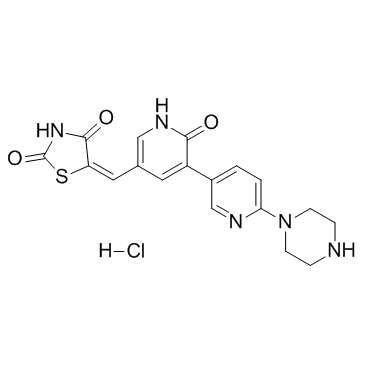Protein kinase inhibitors 1 hydrochloride |
| Catalog No.GC61217 |
Protein kinase inhibitors 1 hydrochloride is a potent HIPK2 inhibitor, with IC50s of 136 and 74 nM for HIPK1 and HIPK2, and a Kd of 9.5 nM for HIPK2.
Products are for research use only. Not for human use. We do not sell to patients.

Sample solution is provided at 25 µL, 10mM.
Protein kinase inhibitors 1 hydrochloride is a potent HIPK2 inhibitor, with IC50s of 136 and 74 nM for HIPK1 and HIPK2, and a Kd of 9.5 nM for HIPK2.
Protein kinase inhibitors 1 hydrochloride is a potent HIPK2 inhibitor, with IC50s of 136 and 74 nM for HIPK1 and HIPK2, and a Kd of 9.5 nM for HIPK2. Protein kinase inhibitors 1 (Compound A64) is not an effective Cdk1 inhibitor (IC50 > 10 μM). A64 is moderately selective across a panel of kinases, with Kds of 3.7 nM (PIM3), 6.1 nM (CSNK2A2), 6.1 nM (CSNK2A2), 8.8 nM (DYRK1A), 9.5 nM (DAPK1), 31 nM (CSNK2A1), 37 nM (PIM1), 130 nM (DRAK2), 150 nM (CLK2), 190 nM (DRAK1), 220 nM (ULK2), 240 nM (CLK1), 250 nM (DYRK2), and 390 nM (ERK8) and IC50s of 19 nM (DYRK1A), 62 nM (DYRK1B), and 74 nM (HIPK2)[1].
[1]. Miduturu CV, et al. High-throughput kinase profiling: a more efficient approach toward the discovery of new kinaseinhibitors. Chem Biol. 2011 Jul 29;18(7):868-79.
| Cas No. | SDF | ||
| Canonical SMILES | O=C(NC/1=O)SC1=C\C2=CNC(C(C3=CC=C(N4CCNCC4)N=C3)=C2)=O.[H]Cl | ||
| Formula | C18H18ClN5O3S | M.Wt | 419.89 |
| Solubility | Water: 9.09 mg/mL (21.65 mM); DMSO: 8.33 mg/mL (19.84 mM) | Storage | Store at -20°C |
| General tips | Please select the appropriate solvent to prepare the stock solution according to the
solubility of the product in different solvents; once the solution is prepared, please store it in
separate packages to avoid product failure caused by repeated freezing and thawing.Storage method
and period of the stock solution: When stored at -80°C, please use it within 6 months; when stored
at -20°C, please use it within 1 month. To increase solubility, heat the tube to 37°C and then oscillate in an ultrasonic bath for some time. |
||
| Shipping Condition | Evaluation sample solution: shipped with blue ice. All other sizes available: with RT, or with Blue Ice upon request. | ||
| Prepare stock solution | |||

|
1 mg | 5 mg | 10 mg |
| 1 mM | 2.3816 mL | 11.9079 mL | 23.8158 mL |
| 5 mM | 0.4763 mL | 2.3816 mL | 4.7632 mL |
| 10 mM | 0.2382 mL | 1.1908 mL | 2.3816 mL |
Step 1: Enter information below (Recommended: An additional animal making an allowance for loss during the experiment)
 g
g
 μL
μL

Step 2: Enter the in vivo formulation (This is only the calculator, not formulation. Please contact us first if there is no in vivo formulation at the solubility Section.)
Calculation results:
Working concentration: mg/ml;
Method for preparing DMSO master liquid: mg drug pre-dissolved in μL DMSO ( Master liquid concentration mg/mL, Please contact us first if the concentration exceeds the DMSO solubility of the batch of drug. )
Method for preparing in vivo formulation: Take μL DMSO master liquid, next addμL PEG300, mix and clarify, next addμL Tween 80, mix and clarify, next add μL ddH2O, mix and clarify.
Method for preparing in vivo formulation: Take μL DMSO master liquid, next add μL Corn oil, mix and clarify.
Note: 1. Please make sure the liquid is clear before adding the next solvent.
2. Be sure to add the solvent(s) in order. You must ensure that the solution obtained, in the previous addition, is a clear solution before proceeding to add the next solvent. Physical methods such as vortex, ultrasound or hot water bath can be used to aid dissolving.
3. All of the above co-solvents are available for purchase on the GlpBio website.
Quality Control & SDS
- View current batch:
- Purity: >98.00%
- COA (Certificate Of Analysis)
- SDS (Safety Data Sheet)
- Datasheet
Average Rating: 5 (Based on Reviews and 38 reference(s) in Google Scholar.)
GLPBIO products are for RESEARCH USE ONLY. Please make sure your review or question is research based.
Required fields are marked with *



















